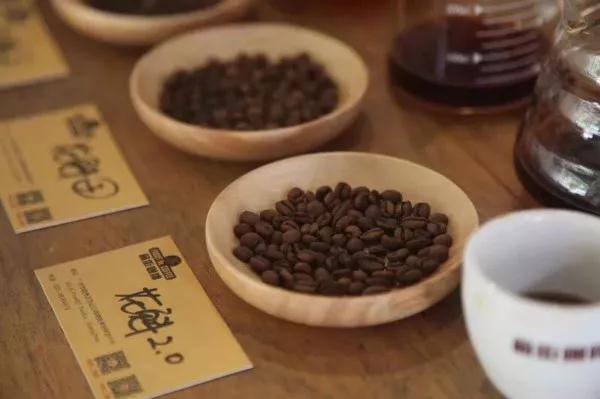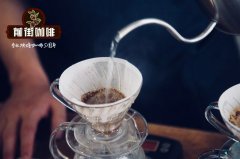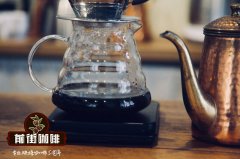What is hand brewed coffee? Know the advantages and characteristics of hand brewed coffee steps and skills
Professional coffee knowledge exchange more coffee bean information please follow the coffee workshop (Wechat official account cafe_style)
If one day in the future, making a cup of hand-made coffee can also be used as an addition to dating or love, you will be glad you clicked into this article!

What are the advantages of hand-brewed coffee? And what are the ways to improve the taste experience of hand-made coffee?

Advantage one: clean
Although the French kettle is also good and close to the essence of coffee, if it is produced, the store will still worry that the filter is "not clean enough":
Because the filter screen of the kettle is a metal mesh, due to pore size and workmanship problems, there is no way to effectively intercept the fine powder of coffee, which leads to a lot of "fine powder precipitation".
Guests can't understand why there is so much residue after drinking this cup of coffee to the end.
So the artifact of the French kettle was once idle. If it is only used at home, I think the French kettle is a very good coffee utensil.

Advantage 2: no smell
Many people think that the smart cup is very stable, put a piece of filter paper, flush the water, and filter it when it's time.
But the biggest disadvantage of the smart cup is that its filter valves are plastic, and if it is not properly maintained, the smell of coffee will have a very heavy "fuel-guzzling smell".
In the past, the body of the smart cup was made of plastic, but now although some people have solved this problem (ceramic), the valve problem has not been effectively solved. (it is believed that it should be solved one day in the future)

Advantage 3: clearness
For a time, the Philharmonic pressure was very hot, and it was found that it could show a better alcohol thickness, but the temperature dropped after it was hot for a period of time. The reason is that we find that the coffee liquid is very cloudy (and the plastic area of the Philharmonic pressure is larger than the smart cup).
PS: since the advantage of Philharmonic pressure is mellow, we can give full play to its advantages in some mixed drinks: for example, Philharmonic pressure milk tea is very delicious (tea powder is soaked in Philharmonic pressure, extracted, added with milk or a little honey, delicious)

Advantage 4: simplicity and safety
The siphon pot was originally the Sakui of the coffee shop, but now the scenery is no longer there. After all, the maintenance and maintenance of the siphon pot is also very troublesome. You need to clean the upper and lower seats, and you also need to maintain the filter cloth (although there is now filter paper to replace the filter cloth. But personally, I think the filter cloth is still better than filter paper.) not only that, the siphon pot is also very easy to bump.
In addition, the siphon pot requires external heating conditions: alcohol lamp, gas, light wave furnace.
Alcohol lamp is not very stable, gas needs to be embedded and fixed, slightly better light wave furnaces have been sold for more than 2000? I once bought a siphon pot made by KONO in Japan, which is good-looking and easy to use, but I would like to remind you: never, never use it to cook instant noodles.

Hand-brewed coffee is clean, odorless, clear, simple and safe. Let human beings, such lazy creatures, finally fall into her arms!
Let's take a look at the conditions that hand punching needs to meet:

The principle of hand-brewing coffee is summed up in one sentence: hot water brings out the coffee liquid through the coffee powder carried by the filter paper.
So as you can see, there are only three really important conditions: coffee powder, filter paper, and hot water.
The reason why many people feel that their hands are in trouble is because they can't grasp the essence and take it seriously on some details:
What kind of hand pot do you want to buy?
What kind of aperture material is better?
What kind of filter cup do you buy?
V60 or trapezoid?
Single hole or three hole or four hole?
Share the pot to buy what kind of aroma preservation is better?
.
This reminds me of the metaphysics in coffee, which is different from coffee made clockwise and counterclockwise.
I said to him: I'll make a pot of coffee now. You can tell whether it's clockwise or counterclockwise. I'll give you a hundred yuan.
The other party was immediately silenced.
Once again, there are only three really important conditions: coffee powder, filter paper, and hot water.
Filter paper is more important than filter cup, many people make great efforts to choose filter cup, but ignore filter paper. It can be said that filter paper is the most neglected link at present.



Let's take a look at the mainstream filter paper on the market: HARIO,KALITA,MOLA,KONO,CHEMEX,BONAVITA,TIAMO,MELITA,BONMAC,ESKIMO...
When we buy filter paper, we don't think too much about it, depending on which kind of filter paper is used more or cheaply.
And these mainstream filter paper, their raw materials, technology, are actually quite different: some Nordic oak, some Finnish wood, some coniferous trees, some Manila banana hemp.
Different raw materials lead to different performance of filter paper in terms of fiber hardness, thickness, water resistance and deformation resistance.
At this point, we have found that the performance of such a dazzling filter paper on the market is actually very different, and sometimes the coffee flavor of the filter paper is different, which is very normal. Filter paper, as a medium for filtering coffee liquid, is actually a very important part of hand-brewed coffee. When most people choose filter paper, they already determine the flavor of coffee. It's not too much to say that.
The most direct function of filter paper is to separate the liquid from the fixed one. The fiber has numerous small holes for liquid particles to pass through, while larger solid particles cannot pass through. The diameter and endurance of the fiber determine its interception ability.
Most importantly, there is no need to wet the filter paper. Once it gets wet, it changes more things. If you are worried that the filter paper smells too strong, why not just change the brand?
To change the finite conditions, it is better to change the whole framework.
If I am asked to choose the biggest rumor about hand-brewed coffee, the first one to bear the brunt is: you can't make coffee in boiling water.
Screw you, Meow. Every time I hear such remarks, I am anxious for the dialectical ability of the other party!
No wonder SCAA (American Fine Coffee Association) specifies the temperature of a cup of coffee at 93 °- 94 °.
This led to the sudden spread of rumors in the streets that the hand temperature should also fall in the range of 90 °- 94 °. Coupled with the emergence of all kinds of temperature control pots, we have raised the specified temperature to an immeasurably high level.
Here I would like to say that using boiling water, that is, 100 °boiling water, to make coffee, there is no problem at all!
After repeated tests with the concentration tester, it is found that the higher the temperature, the higher the extraction.
Some people say, will the high extraction rate bring bitterness and miscellaneous taste?
When will such logical shackles be broken? Why can't you allow a person to be good-looking, rich and diligent?
The idea of binary opposition has always shackled people: only one condition can be allowed to develop.
It seems that "the extraction rate is high, but the flavor is good." it is a very painful thing to admit such a fact. Don't simply attribute everything. Extraction takes place under multiple conditions at the same time. Don't let boiling water carry bitter and mixed pots.
By the way, the temperature of most temperature-controlled pots on the market is very limited, and friends who are interested in boiling water can use household hot water kettles. (by the way, please give up the part of wet filter paper.)
Do not ask me what filter cup to buy, put aside other conditions, the most controllable is V60, the other single hole, two holes, three holes, four holes. There are all baffles in the middle, only the bottom of V60 is hollowed-out design.
Even if you are an 18-hole design, there will still be a bezel in the middle. Because the aperture needs to be carried out on the plane. V60 more witty, no hole than hole design is very philosophical.
The speed of launching is not determined by the pore diameter, but by the filter paper.
Aperture is an interference factor, not the first factor. The flow rate of coffee is like a stream, and the aperture and baffle are obstacles.
Finally, let's make a bubble of 2018 Sakuran.
Ethiopian Sidamo Shakisso Natural

Product name: Ethiopia Sunshine Sidamo G1 Sakuran
Ethiopian Sidamo Shakisso Natural
Coffee producing countries: Africa Africa, Ethiopia Ethiopia
Coffee Manor: Guji Guji, Hambella Wamena Humbela, buku able Manor
Coffee variety: Heirloom (native to Ethiopia)
Production altitude: 2250-2350m
Quality level: G1
Treatment: Natural tanning (African drying bed)


Filter cup: Hario v60
Scale: little Fuji 3.5
Water temperature: 90 ℃, ratio of water to flour 1:15
Flushing and cooking techniques: 25 g of water is injected for steaming for 30 seconds, vertical water injection and slow circle to 120 grams of water are carried out in sections, and larger water injection ends at 226 grams.
Total time: 2 minutes 05 seconds

The first part smells obvious melon aroma, strawberry jam, the mouth with jackfruit-like soft acidity, middle strawberry berry flavor emerged, there are some sugar back sweet, rich layers.
Important Notice :
前街咖啡 FrontStreet Coffee has moved to new addredd:
FrontStreet Coffee Address: 315,Donghua East Road,GuangZhou
Tel:020 38364473
- Prev

How does Brazilian yellow bourbon coffee taste? Brazilian coffee yellow bourbon hand-brewed method
Professional coffee knowledge exchange more coffee bean information please follow the coffee workshop (Wechat official account cafe_style) hand-brewed coffee lovers unexpectedly bought yellow bourbon, so how to make Brazilian coffee [yellow bourbon]? In order to introduce the Brazilian coffee yellow wave side-by-hand flushing method. Front street coffee hand flushing reference: weigh 15g of [yellow bourbon] coffee powder, pour into a grinder and grind moderately
- Next

The difference and comparison between single product and blending: different flavor and taste
Professional coffee knowledge exchange more coffee bean information Please follow the coffee workshop (Wechat official account cafe_style) when coffee lovers buy coffee beans, they may encounter the problem of not knowing whether to buy beans or blending coffee beans at first. Do you have to use single coffee beans for hand-brewed coffee and coffee beans for Italian style? Today, let's talk about individual items again.
Related
- Beginners will see the "Coffee pull flower" guide!
- What is the difference between ice blog purified milk and ordinary milk coffee?
- Why is the Philippines the largest producer of crops in Liberia?
- For coffee extraction, should the fine powder be retained?
- How does extracted espresso fill pressed powder? How much strength does it take to press the powder?
- How to make jasmine cold extract coffee? Is the jasmine + latte good?
- Will this little toy really make the coffee taste better? How does Lily Drip affect coffee extraction?
- Will the action of slapping the filter cup also affect coffee extraction?
- What's the difference between powder-to-water ratio and powder-to-liquid ratio?
- What is the Ethiopian local species? What does it have to do with Heirloom native species?

